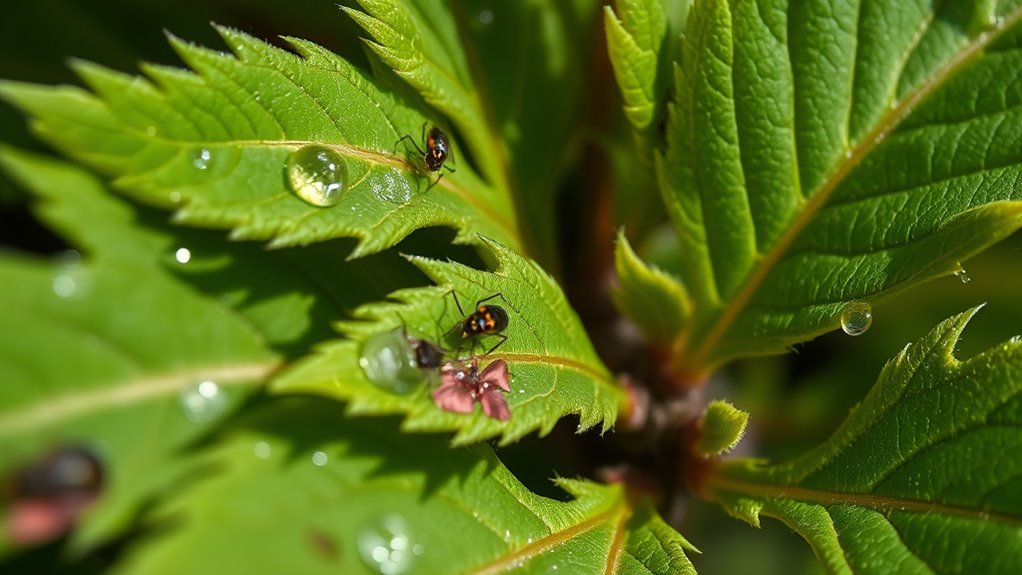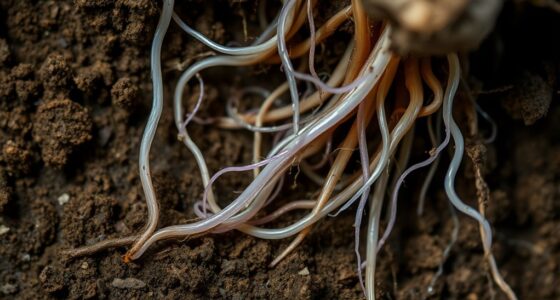When pests attack, plants send out chemical signals called volatile organic compounds (VOCs) to alert nearby plants and attract helpful insects like predators. They actively recognize the threat and respond by strengthening defenses or releasing more chemicals to summon assistance. This complex communication acts like a biological SOS, ensuring survival. If you want to uncover how these signals work and the plant’s incredible defense system, keep exploring these fascinating processes.
Key Takeaways
- Plants release volatile organic compounds (VOCs) as chemical signals when damaged by pests.
- These chemical cues alert neighboring plants to activate defenses like producing bitter compounds.
- Plants can distinguish different threats and respond accordingly, such as attracting predatory insects.
- Additional detection methods include electrical signaling, enhancing their ability to call for help.
- The plant communication network creates an ecological web that supports coordinated pest defense.

When pests attack, plants don’t just sit passively—they send out signals to summon help. This remarkable process is part of their plant communication system, allowing them to alert nearby plants and even attract beneficial insects to fight off the attackers. When you consider how plants defend themselves, it’s easy to overlook how actively they participate in their own survival. They’re not defenseless; instead, they rely on sophisticated pest detection mechanisms that trigger their SOS signals. These mechanisms help them recognize when they’re under threat and respond quickly.
Your plants detect pest invasions through a range of sensory systems embedded in their tissues. When insects feed on leaves or roots, they cause physical damage and release chemical signals. For example, damaged plant cells emit volatile organic compounds (VOCs), which act as distress signals. These chemical cues aren’t random; they’re carefully calibrated to alert other parts of the plant and neighboring plants about the danger. Once these signals are sent out, nearby plants can respond by activating their own defense systems, such as producing bitter-tasting compounds or strengthening their cell walls to make it harder for pests to feed.
Plants detect pests through chemical signals like VOCs, alerting themselves and neighbors to activate defenses.
The pest detection mechanisms are highly sensitive and specific. They can distinguish between different types of threats, allowing plants to tailor their responses appropriately. For instance, when a plant senses caterpillar chewing, it might produce certain chemicals that attract predatory insects, like ladybugs, which feed on the pests. Conversely, if it detects a fungal attack, it might activate antifungal defenses. This ability to discern different threats is vital for conserving energy while mounting an effective defense. It’s like a biological alarm system that not only detects trouble but also communicates it clearly, ensuring the right help arrives.
Furthermore, recent studies suggest that some plants can even detect the presence of pests through electrical signals, providing another layer of their complex detection system. You might not realize it, but this communication isn’t limited to just the plant itself. It’s part of a larger ecological network. When one plant sends out distress signals, it can influence the behavior of neighboring plants, prompting them to preemptively bolster their defenses. It also attracts beneficial insects that help keep pest populations in check. This complex web of plant communication and pest detection mechanisms creates a dynamic battlefield where plants are constantly alert and responding. It’s a testament to how plants, despite lacking brains or nerves, have developed intricate systems for survival.
In essence, understanding how plants detect pests and communicate their distress underscores their resilience. They actively participate in their defense, using chemical signals and communication networks that help them survive in a world full of threats. So, next time you see a plant thriving amid pests, remember that it’s likely using these sophisticated pest detection mechanisms to call for help and defend itself effectively.
Frequently Asked Questions
Can Humans Use Plant SOS Signals to Protect Crops?
Yes, you can use plant SOS signals to protect crops. By understanding chemical signaling, you can develop sensors that detect pest-induced changes in plants. These sensors help with pest detection early, allowing you to act swiftly. Monitoring these signals enables targeted pest control, reducing pesticide use and protecting your crops more effectively. This approach leverages natural plant responses to keep your crops healthy and pest-free.
Do All Plants Emit the Same Distress Signals?
You might think all plants speak the same language, but that’s far from true. Not all emit the same distress signals; instead, they use diverse chemical communication methods. This signaling diversity allows each plant species to respond uniquely to threats, making their alarm systems as varied as a forest’s colors. So, their distress signals are as different as fingerprints, tailored to their environment and survival strategies.
How Quickly Do Plants Respond to Pest Attacks?
You’ll find that plants respond to pest attacks remarkably quickly, often within minutes to hours. They use plant hormone signaling to activate defenses and release chemicals that communicate danger to nearby plants. This chemical communication helps create a protective environment, alerting other plants to prepare for potential pests. Your awareness of these rapid responses highlights how plants actively defend themselves through sophisticated signaling systems, ensuring survival despite ongoing threats.
Can Plants Recognize Specific Pests and Tailor Their Responses?
Imagine a plant as your savvy friend in a sci-fi movie, recognizing specific pests. You’d be surprised, but yes, plants use chemical communication to detect different pests and tailor their responses. They release predator deterrents targeted at particular attackers, effectively calling for help and discouraging pests. This ability to recognize specific threats shows how sophisticated plant responses are, almost like having an innate pest ID system.
Are Plant SOS Signals Affected by Environmental Conditions?
Environmental impact can influence plant SOS signals, causing signal variability. When conditions like drought, temperature, or pollution change, plants may alter how they produce or transmit these distress signals. You might notice that in harsh environments, signals become weaker or different, making it harder for neighboring plants to respond effectively. So, environmental factors directly affect the strength and clarity of plant SOS signals, impacting their overall communication during pest attacks.
Conclusion
Just imagine you’re walking through a garden, unaware of the silent distress signals plants send out. When pests attack, these green warriors call for help with chemical cries that reach nearby allies. Like a secret handshake in a bustling crowd, their SOS signals create a web of defense, turning the garden into a living fortress. So, next time you see a plant thriving against the odds, remember it’s not just surviving—it’s summoning its own army.










